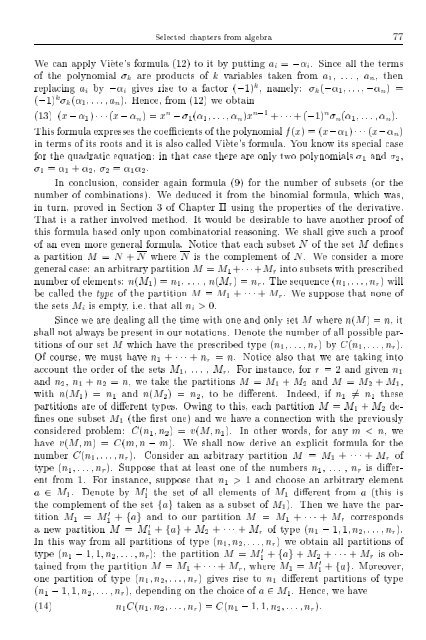SELECTED CHAPTERS FROM ALGEBRA I. R. Shafarevich Preface
SELECTED CHAPTERS FROM ALGEBRA I. R. Shafarevich Preface
SELECTED CHAPTERS FROM ALGEBRA I. R. Shafarevich Preface
Create successful ePaper yourself
Turn your PDF publications into a flip-book with our unique Google optimized e-Paper software.
Selected chapters from algebra 77We can apply Viete's formula(12)toitby putting a i = ; i . Since all the termsof the polynomial k are products of k variables taken from a 1 , ... , a n , thenreplacing a i by ; i gives rise to a factor (;1) k , namely: k (; 1 ... ; n ) =(;1) k k ( 1 ...a n ). Hence, from (12) we obtain(13) (x ; 1 ) (x ; n )=x n ; 1 ( 1 ... n )x n;1 + +(;1) n n ( 1 ... n ):This formula expresses the coecients of the polynomial f(x) =(x; 1 ) (x; n )in terms of its roots and it is also called Viete's formula. You know its special casefor the quadratic equation: in that case there are only two polynomials 1 and 2 , 1 = 1 + 2 , 2 = 1 2 .In conclusion, consider again formula (9) for the number of subsets (or thenumber of combinations). We deduced it from the binomial formula, which was,in turn, proved in Section 3 of Chapter II using the properties of the derivative.That is a rather involved method. It would be desirable to have another proof ofthis formula based only upon combinatorial reasoning. We shall give such a proofof an even more general formula. Notice that each subset N of the set M denesa partition M = N + N where N is the complement of N. We consider a moregeneral case: an arbitrary partition M = M 1 ++M r into subsets with prescribednumber of elements: n(M 1 )=n 1 , ... , n(M r )=n r . The sequence (n 1 ...n r ) willbe called the type of the partition M = M 1 + + M r . We suppose that none ofthe sets M i is empty, i.e. that all n i > 0.Since we are dealing all the time with one and only set M where n(M) =n, itshall not always be present in our notations. Denote the number of all possible partitionsof our set M which have the prescribed type (n 1 ...n r )by C(n 1 ...n r ).Of course, we must have n 1 + + n r = n. Notice also that we are taking intoaccount the order of the sets M 1 , ... , M r . For instance, for r = 2 and given n 1and n 2 , n 1 + n 2 = n, we take the partitions M = M 1 + M 2 and M = M 2 + M 1 ,with n(M 1 ) = n 1 and n(M 2 ) = n 2 , to be dierent. Indeed, if n 1 6= n 2 thesepartitions are of dierent types. Owing to this, each partition M = M 1 + M 2 de-nes one subset M 1 (the rst one) and we have a connection with the previouslyconsidered problem: C(n 1 n 2 ) = v(Mn 1 ). In other words, for any m < n, wehave v(Mm) = C(m n ; m). We shall now derive an explicit formula for thenumber C(n 1 ...n r ). Consider an arbitrary partition M = M 1 + + M r oftype (n 1 ...n r ). Suppose that at least one of the numbers n 1 , ... , n r is dierentfrom 1. For instance, suppose that n 1 > 1 and choose an arbitrary elementa 2 M 1 . Denote by M1 0 the set of all elements of M 1 dierent from a (this isthe complement oftheset fag taken as a subset of M 1 ). Then we have the partitionM 1 = M1 0 + fag and to our partition M = M 1 + + M r correspondsa new partition M = M1 0 + fag + M 2 + + M r of type (n 1 ; 1 1n 2 ...n r ).In this way fromall partitions of type (n 1 n 2 ...n r ) we obtain all partitions oftype (n 1 ; 1 1n 2 ...n r ): the partition M = M1 0 + fag + M 2 + + M r is obtainedfrom the partition M = M 1 + + M r , where M 1 = M1 0 + fag. Moreover,one partition of type (n 1 n 2 ...n r ) gives rise to n 1 dierent partitions of type(n 1 ; 1 1n 2 ...n r ), depending on the choice of a 2 M 1 . Hence, we have(14) n 1 C(n 1 n 2 ...n r )=C(n 1 ; 1 1n 2 ...n r ):
















